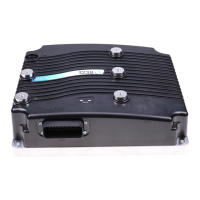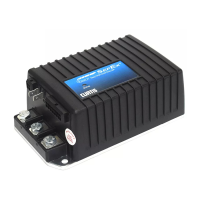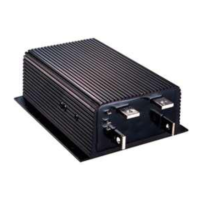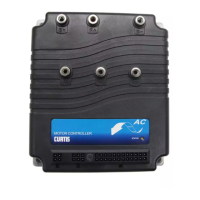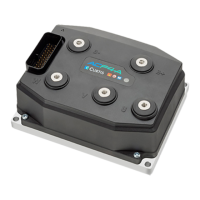4 — PROGRAMMABLE PARAMETERS
pg. 85
Return to TOC Curtis AC F4-A Motor Controller – August 2020
CONTROLLER SETUP
Use the menus within the Controller Setup to congure the controller’s inputs and output signals at
the low-voltage (35-pin connector) and the current and power at the UVW motor-phase and Battery
connections. e Inputs menu is where the analog inputs are setup and assigned. Following the Inputs
menu are the IO Assignments, Outputs (coil drivers), External Supplies, and Current Limits menus.
CONTROLLER SETUP — INPUTS MENU
e Inputs parameter menu describes the optional usages for Analog 1, 6, 18, and 19. Based upon
these input’s setup selection, the CIT and 1313 HHP Programmer app will open and/or hide a
dierent set of menu options. is is the context sensitivity aspect of the F-series programmer menus.
e Analog Inputs 1, 6, 18, and 19 are selectable for use as Voltage, 3-Wire Potentiometer, 2-Wire
Potentiometer, or a Voltage with Supply input. Based upon the selection, the available (visible) setup
menus will dier. Review all the descriptions, below, to select the optimum option for the application.
• When conguring either Analog Input 1 or Analog Input 6 as a 3-Wire Potentiometer input,
the Programmer app will pair these inputs. e 3-wire input is the wiper and the other
becomes the 5V supply, labeled high. For example, Figure 6 has Input 1 as the 3-wire wiper,
while Input 6 is the supply (high). If Input 6 is set as the 3-wire (wiper), Input 1 will become
the 5V supply (high). In all cases, the actual potentiometer wiper connects to ground (pins 7 or
18) as illustrated in Figures 6 and 25.
• e same type of coupling is true with Analog Input 18 (paired with Analog 19) if its 3-Wire
Potentiometer is selected.
e other Analog inputs, 2 – 5, 7 – 9, 14, and 31 are voltage inputs. In a typical application, as shown
in Figures 6 and 7, the drive motor temperature sensor is Analog 2. e motor encoder signals are
Analog 3 and 4.
Input 10 is included at the top of the Inputs menu because it is congurable for either an analog
frequency or duty cycle input, beside its typical digital switch input. Figure 21 illustrates how this
input’s optional signal chain operates. Note that this controller does not have a PWM Input 17.
Disregard this input if it is shown in CIT/1313.
Note that the analog input's usage as a digital (switch) input has a higher normalization range
(analog_input_x_high) maximum voltage limit of 30 volts. is allows their usage as digital (switch)
inputs without causing a voltage out-of-range fault. is does not change the indicated limits for an
input's analog measurement (usage) range.
Quick Links:
Fig. 6 p.10
Fig. 7 p.11
Fig. 25 p.135
